Effect of Protein Supplementation plus Hyper-Caloric intake and Exercise on Hypertrophy, Hormones and Energy components among Underweight Males
Syed Ibrahim*, Abdulhameed Al-Ameer, Hamed Abu-Hilal, John Allen, Phillip Watkins
Physical Education Department, King Fahd University of Petroleum & Minerals, Dhahran, 31261, Saudi Arabia.
*Email: sibrahim @ kfupm.edu.sa
ABSTRACT
The purpose of the study was to examine the efficacy of 8 weeks of protein supplementation plus hyper-caloric intake and resistance training on hypertrophy, hormones, and energy components of underweight males. One hundred sixty-seven underweight males from Dhahran region aged 18 to 20 years with BMI of less than 18.5 Kg/m2 were divided into protein supplementation with hyper-caloric intake and resistance training group 1 (G-1, n =21), the resistance training group 2 (G-2, n=48), protein supplementation group 3 (G-3, n=32) and a control group 4 (G-4, n=38). The subjects were measured before and after the training Physical Characteristics (PC) [body mass (BM), optimal body mass (OBM), height (H), body mass index (BMI), percent body fat (%BF), fat-free mass (FFM)], hormones [Triiodothyronine (FT3), Thyroxine (FT4), Thyroid-stimulating hormone (TSH), cortisol and testosterone], energy components, food intake (FI), energy needs (EN) and 1Resistance Maximum (1RM) tests [leg press (LP), chest press (CP) and abdomen press (ABDO)]. The resistance training (RT) was for 8 weeks, twice per week 30 minutes per session for G-1 and G-2. The data was analyzed using SPSS version 20.0 software. Mean and the standard deviation was calculated for all subjects. One-way analysis of variance (ANOVA) was utilized to compare the mean differences between groups and the level was at P≤0.05. The results showed that BM and FFM had main effects for time and interaction effects for a time by groups (P<0.05) but not for groups (P>0.05). In 1RM strength tests for LP, CP, and ABDO there were main effects for the time, groups, and interaction effects for time for groups (P<0.05). FT3 and FT4 showed main effects for time only (P<0.05) but TSH, CORTI, and TESTO did show any changes. FI showed main effects for the time, groups, and interaction effects for a time by groups (P<0.05). It was concluded that the intervention program helps in gaining bodyweight and increasing the fat-free mass. Besides, the resistance training aided to raise the strength, food intake with no changes in the hormones.
Key words: Underweight, resistance training, protein supplementation, hyper-caloric intake.
INTRODUCTION
Protein supplements are nutritional techniques that can develop exercise performance, capacity, and enhance training effectiveness [1-3]. It has been observed from the literature that protein supplementation plays a fundamental part in the skeletal muscle adaptation to resistance exercise by increasing protein synthesis to a larger degree [4]. Scientists confirmed that protein supplementation provided immediately before or after the session of resistance training will increase the performance as well as muscle hypertrophy [5, 6]. Protein supplements can be provided in the form of tablets, capsules, soft gels, liquids, powders, and bars [7].
Resistance training (RT) builds up the muscle and skeletal system, improves muscle tone, muscle size, strength and endurance [8-11]. Several previous studies indicated increases in strength ranging between 6 to 66% after RT [12, 13].
Several earlier researchers on elite male and female athletes (Mocanu 2013, Drenowatz et al., 2012) studied the energy expenditure (EE) and the food intake (FI) [14, 15]. They found out that EE exceeded significantly the FI from -346 to -6096 kcal/day. However, the literature revealed that only one study investigated underweight Kenyan elite male runners [16].
The thyroid hormones control the velocity of the energy use, the sensitivity of the body to other hormones, and produce proteins, tri-iodothyronine (T3) and thyroxine (T4). T3 and T4 accelerate cellular reactions, increase metabolism, and help increasing cardiac output and heart rate [17, 18]. Thyroid-stimulating hormone (TSH) is secreted by the anterior pituitary gland and it is stimulated when the thyroxine level falls in the blood [19, 20]. The flow of the TSH is inhibited when the thyroxine concentration is high. One of the earlier studies pointed out an increase in T4 and no change in T3 and TSH after 8 weeks of Taekwondo training [21]. However, another study reported no change in T3, T4, and TSH after 8 weeks of resistance training among active male students [22]. Testosterone is an anabolic steroid that contributes to muscle hypertrophy [23]. Many controversies existed in previous studies regarding the outcomes of the effect of testosterone on muscle hypertrophy. Some investigations reported increases in testosterone after resistance training (Yan et al. 2015, Gorostiaga et al. 2004) while, others indicated no changes [24-26]. Cortisol is a catabolic hormone mainly responsible for the degradation of protein, thereby increasing the type of І muscle fiber hypertrophy [27]. Some studies reported a decrease and increase in cortisol concentration after resistance training [26, 28].
Being underweight is a global health complication related to some therapeutic threat elements such as hyperthyroidism, malnutrition, sickness, or could have hereditary origins [29]. The underweight subject has a low desire for consuming food and a small stomach. The literature in the area of underweight athletes is not enough and more attention was directed to the elite normal weight athletes [14, 16, 30]. Therefore, to improve the underweight subject's health, resistance training, protein supplementation plus hyper-caloric intake were used to contribute significantly to the adaptation of muscle hypertrophy. In our observation, there are no research studies that considered the impact of 8 weeks of combined protein supplementation plus hyper-caloric intake and resistance training among underweight males using optimal body mass (OBM) as a tool for calculating the energy needs. Therefore, this research aimed to compare the effect of combined protein supplementation plus hyper-caloric intake and resistance training on one side, and protein supplementation alone, resistance training alone on hormones, energy components and hypertrophy of underweight males on the other side.
METHOD
Subjects
One hundred twenty-eight underweight males from Dhahran and the nearby zones, aged between 18 to 20 years participated in this investigation. The selection of subjects was based on possession of BMI less than 18.5 kg/m2. The subjects were divided into four groups, protein supplementation plus hyper-caloric and resistance training group 1 (G-1, n = 21), resistance training group 2 (G-2, n = 48), protein supplement group 3 (G-3, n = 32) and a control group 4 (G-4, n = 28). The control group did not undergo resistance training or protein supplementation or hyper-caloric intake. However, they were instructed to continue their normal lifestyle and refrain from any resistance training, protein supplementation, and hyper-caloric intake. The willingness of the subjects was ascertained for their voluntary participation during the study period. They were asked to sign an agreement of participation in the 8 weeks of study in addition to the acceptance of drawing of blood samples. The subjects were asked to withdraw their consent in case they felt any discomfort during the period of participation.
Experimental Approach to the Problem
The study variables tested were physical characteristics (H, BM, OBM, BMI, %BF, FFM), 1RM Tests (LP, CP, AP), hormones (T3, T4, TSH, Testosterone, and Cortisol) and energy elements (FI, EN).
Physical Characteristics (PC)
All groups were measured before and after the training period for PC. Before the commencement of the training, their height was measured to the nearest cm with bare feet by a stadiometer. The BM, BMI, %BF, and FFM were measured using TANITA DC 430 MA P, Japan. The OBM was calculated according to a method used by Hermassi et al. (2011) [31].
Hormones
All hormones were measured one week before and after the training period. The blood samples were taken and analyzed by the KFUPM Medical Centre, Dhahran for T3, T4, TSH, cortisol, and testosterone.
Energy Components (EC)
The EC was measured for food intake (FI) and energy needs (EN).
Food Intake (FI)
A food list was supplied to all subjects to tick mark the food items consumed. After collecting the food list, the investigators calculated the FI manually 3 times per week in weeks 1, 4, and 8.
Energy Needs (EN)
The EN was calculated before the training period as follows:
BMR x 1.3 (light activity level) [32].
Procedures of Diet and Protein Supplementation
The EN was calculated according to the subject’s optimal body mass (OBM) before the start of the training period, asking the subject to have his FI in the food center of KFUPM for 8 weeks, 3 times per day. Then the actual FI was compared with the EN. If the actual FI was found to be less than the EN, he was asked to increase his FI to correspond with his EN. The subjects of G-1 and G-3 were provided with 30 grams of oral protein supplementation 2 times per week for 8 weeks immediately after the resistance training session. The subjects consumed oral supplements in the presence of a research assistant to confirm the intake.
Hypertrophy
To achieve hypertrophy, the intensity of RT ranged from 67 to 85% of 1RM, the repetition of each drill session was 6-12 with a rest period of 30 to 90 seconds between sets [33].
1RM Tests
The 1RM test was administered to all groups before and after the 8 weeks of training period on the leg press (LP), chest press (CP), and abdominal Press (AP). The subject was asked to lift the weight once if he succeeds, he was asked to lift the next weight until he fails. There was a rest period of 3-5 min between trials.
Resistance Training (RT)
G-1 and G-2 participated in the RT for 8 weeks, twice per week, and 30 minutes per session. The RT was performed in the KFUPM gymnasium using weight machines and free weights. The adaptation stage started one week before the training period. Warm-up and cool-down sessions of 5 min each took place before the start and the end of the training. The intensity of training was 67% of 1RM with 12 reps in week 1. In week 2, it was 75% with 10 reps. In week 3, it was 77% with 9 reps. In week 4, it was 80% with 8 reps. In week 5, it was 83% with 7 reps. In weeks 6 and 7, the intensity was constant at 85% with 6 reps. During the last week, it was 67% with 12 reps for testing purposes. The RT consisted of 5 sets for each exercise with rest periods of 30 to 90 seconds between sets [33].
Data Analysis
The means and the standard deviations were calculated for all values using SPSS version 20.0 software. One-way analyses of variance (ANOVA) was utilized to compare the mean differences between groups (age, H, OBM, BMI, and EN). The Scheffe’s post hoc was used for unequal samples. ANOVA with repeated measures was utilized to find out the main effects for the time, groups, and the interaction effects of time by groups. The level of significance was set at P ≤ 0.05.
RESULTS
Table 1: Physical component mean and standard deviation (±SD) values for four groups of underweight subjects at pre and post-training
|
Group |
Age |
H |
BM |
BMI |
%BF |
FFM |
|||
|
Pre |
Post |
Pre |
Pre |
Post |
Pre |
Post |
|||
|
1 |
19.1±0.4 |
171.2±5.1 |
51.3±4.1 |
52.9±3.8 |
17.5±0.9 |
10.5±3.4 |
10.5±3.0 |
45.9±4.0 |
47.4±4.0 |
|
2 |
19.1±0.4 |
170.6±6.1 |
49.6±5.1 |
50.5±5.0 |
17.1±1.2 |
8.6±3.7 |
9.7±3.5 |
44.9±3.9 |
45.5±4.0 |
|
3 |
19.1±0.4 |
170.6±6.2 |
50.1±4.8 |
50.7±4.5 |
17.2±1.0 |
9.2±4.5 |
9.3±4.2 |
45.3±3.8 |
45.8±3.7 |
|
4 |
19.1±0.3 |
169.1±6.7 |
48.7±4.6 |
49.1±4.9 |
16.9±1.1 |
8.6±3.7 |
8.8±3.7 |
43.8±4.1 |
44.7±4.1 |
One way ANOVA revealed that age, H, and BMI had similar outcomes between groups (P ˃ 0.05). BM and FFM exhibited the main effects of time and interaction effects of time by groups (P ˂ 0.05) but there was no main effect for groups (P ˃ 0.05). The %BF indicated no main effects for time and groups or an interaction effect of time by groups (P ˃ 0.05). These results can be seen in Table 1.
In Figures 1, 2, and 3, the 1RM strength tests for LP, CP, and ABDO revealed main effects for the time, groups, and interaction effects of time by groups (P ˂ 0.05). In LP, G-1 showed greater value (P˂0.05) than G-3 and G-4 but no changes for the others (P ˃ 0.05). In CP, G-1 revealed a higher value than G-2, G-3, and G-4 (P ˂ 0.05) but the others had similar values (P ˃ 0.05). In ABDO, G-1 showed greater value (P ˂ 0.05) than G-2, G-3, and G-4. G-2 also showed more value than G-4 (P ˂ 0.05) but no changes for the others (P ˃ 0.05).
In Figure 4, for FI, there were main effects of time, groups, and interaction effects of time by groups (P ˂ 0.05). FIW8 exhibited greater value than FIW1 and FIW4 (1691.87 ± 630.41, 1437.62 ± 554.05 and 1654.96 ± 595.44 Kcal respectively, P ˂ 0.05). G-1 stated greater value than G-4 but there was no change in the others
In Figures 5, 6, 7, 8, and 9, the FT3 and the FT4 showed main effects for time (P ˂ 0.05) but no changes for groups or interaction effects of time by groups (P ˃ 0.05). The TSH, CORTI, and TESTO did not show any main effects of time, groups, and interaction effects of time by groups (P ˃ 0.05).
Figures showing the values of 1RM Leg Press, Chest Press, Abdomen and Food Intake
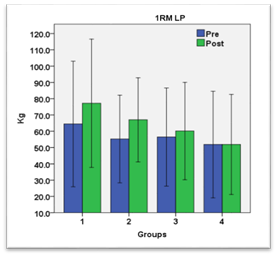
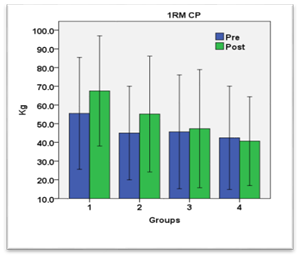
Figure 1- 1RM Leg Press Figure 2- 1RM Chest Press
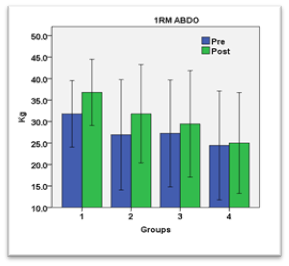
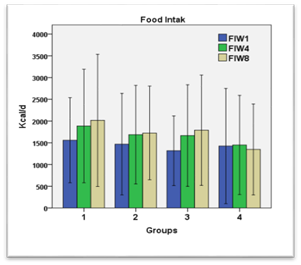
Figure 3- 1RM Abdomen Figure 4- Food Intake
Figures showing the Blood Profile
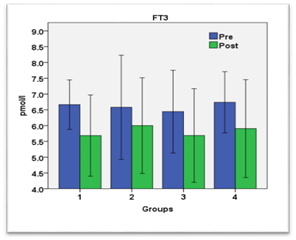
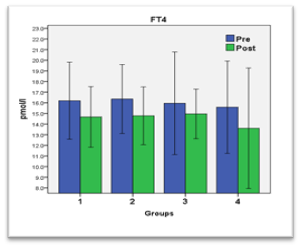
Figure 5- FT3 Figure 6- FT
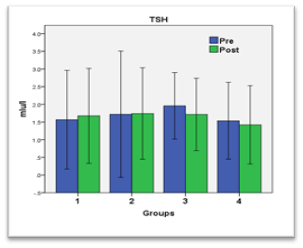

Figure 7- TSH Figure 8- Cortisol
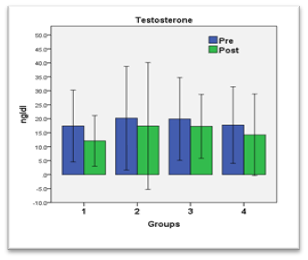
Figure 9- Testosterone
DISCUSSION
Our goal in this study was to find out the efficacy of 8 weeks of protein supplementation plus hyper-caloric intake and resistance training on hypertrophy, hormones, and food intake of underweight males. Our results revealed positive trends regarding hypertrophy, 1RM strength tests, and FI. However, it showed negative outcomes for all hormone tests and body fatness.
In the present scenario, there has been growing awareness among the individuals in employing dietary control to preserve their health, welfare, and to support a healthy lifestyle. Ample consumption of protein is a strategic nutritional feature to sustain independence, primarily by inhibiting deficiency of muscle mass and power (sarcopenia), fragility, and related disorders in future lifespan [34]. Presently, the food segment is inconsistent to detect and openly respond to the prerequisites of this populace, with reasonable, edible, and concrete food solutions [35]. The category, which suffers most is the underweight individuals since they have less muscle mass, strength, and fragility. The existing study employed the supplementation of protein along with the hyper-caloric intake and exercise to identify how they can alter the hypertrophy, hormones, and energy components in underweight subjects.
Body composition points to everything in our body, divided into diverse compartments mainly fat mass and fat-free mass. Numerous studies have specified that muscle mass, which constitutes a significant aspect of body composition, can be enriched through specific training modalities [36, 37]. Muscles frequently surge incapacity resulting in an increase in mass after undergoing training. It is a well-known datum that the muscles are made up of many distinct fibers and with training, they conditionally augment due to the growth of some fibers known as hyperplasia or there is an enrichment in the dimension of a single muscle fiber termed as hypertrophy [38]. Healthy weight gain in the form of acquiring and up keeping the lean muscle mass can be attained if a particular training is practiced three times per week. Results from our study showed that the physical components like body mass and free fat mass showed main effects for time and an interaction effect of time by groups but not for groups. Also, the group I showed a substantial increase in both the BM and FFM which contends well from the literature above and in line with the results of Osama et al, (2020), Resnick et al, (2018), Walker et al, (2016), Josse et al, (2010), Hartmen et al, (2007) who recorded increases between 18 and 37%. [39-43] However, contrary to Schoenfeld et al, (2014), Ballard et al, (2006) stated no remarkable variation, which is dissimilar to the results of this study [44, 45].
Resistance training is normally recommended to foster primary strength and power abilities in an endeavor to expand physical feats. The improvement of these abilities may be achieved from a variety of probable adjustments containing enhanced neuromuscular recruitment and skeletal muscle strength. Moreover, in contact sports like rugby, bigger competitors have fair supremacy where strength is associated with triumph [46]. This is revealed in the scientific works with substantial thought given to resistance training involvements to assist muscle tenacity [4]. Abundant research investigations have utilized resistance training to induce gains in strength and have confirmed surges from 0.05 to 1.9 for 1-resistance maximum (1RM) in leg press and chest press [47]. Although, there are very few explorations done on the use of resistance training in underweight subjects except the study of Almoslim et al, (2017) who utilized RT and found that it enhances the strength of the underweight individuals [48]. Our study revealed that there were main effects for the time, group, and interaction effect of time by groups P >0.05 for the 1RM strength tests of LP and CP. These results are supported by the studies of Barbalho et al, (2018), Campbell et al, (2018), Seo et al, (2012), Abdul Hamed et al, (2012) who had similar effects for the upper and lower body parts [49-52]. In our study, we also utilized the ABDO 1RM test that also showed the same significant effects like LP and CP which the other studies did not administer. This apart from the group that indulged in RT, Protein supplementation, and hyper-caloric diet improved in all the 1RMs than the other three groups suggesting that the above intervention program is the best for improving strength.
The metabolic activity regulation and a variety of actions on every organ in our body are controlled by Thyroid hormones. Thyroxine (T4), triiodothyronine (T3) and reverse triiodothyronine (rT3) are the main hormones manufactured by Thyroid. Thyroid-stimulating hormone (TSH) present in the anterior pituitary gland controls these hormones. When discharged into circulation, T3 and T4 apply their metabolic effects on numerous organs, comprising the heart, bone, and metabolism [53]. Thyroid hormones T3 and T4 work in harmony to preserve appropriate negative response and when their levels rise, they move to the hypothalamus and anterior pituitary to put off the discharge of TRH and TSH respectively. When their levels are decreased, TRH and TSH genes are turned on to surge their manufacturing and aid in the rise of their levels. Very few studies have utilized the effect of weight training, hypercaloric diet, and protein supplementation to find out how it alters the thyroid hormones. The outcomes of our study displayed a change in the thyroid hormones of T3, T4 after the intervention schedule, which validates with the studies of Altaye et al, (2019), Bansal, et al, (2015), Ciloglu et al, (2006) [54-56]. On the contrary, Kouidrat et al, (2019), Rahimi et al, (2013), Fontana et al, (2006) found no change in their conclusion about the thyroid hormones T3 & T4 that contradicts the outcome of our study [22, 57, 58]. Concerning TSH, the present investigation did not discover any noteworthy change as supported by Kouidrat et al, (2019) and Bansal et al, (2015) [55, 57]. Exercise is a potent impetus for the endocrine system, transforming the plasma concentration of several hormones, together with steroids like testosterone and cortisol [59]. Testosterone is a key anabolic hormone, whereas cortisol yields normal catabolic properties. The literature reveals that plasma dissimilarity of testosterone and cortisol ensues in response to constant exercise. Testosterone and cortisol intensities after physical exercise are also influenced by the length and force of exercise. There were no significant effects in both the testosterone and cortisol hormones in our study which is backed by the studies of Bolados et al, (2019), Hackney et al, (201), and Hayes et al, (2012) who stated similar results [60-62].
Numerous inquiries on nutrition have revealed that adequate food consumption can augment body mass. Inadequate calorie intake results in underweight and many other health problems [63]. The problem of underweight can be resolved if there is a well-directed diet program, appropriate hydration, liquid supplementation, and the intake of required minerals and vitamins. The underweights can augment their food intake and indulge in physical activity to be normal-weight individuals [64]. The present study involved hyper-caloric intake in which the participants were advised to increase their food intake from the start of the intervention. The results pointed out that there were significant effects in the increase of the food intake that is supported by the studies of Holder, (2019), Lesani et al, (2016), Bradley et al, (2017), Garthe et al., (2013) [34, 65-67]. The outcomes also showed that the experimental group 1 showed greater value and consumption of food intake than the control group with no change in the other groups.
CONCLUSION
The current study demonstrated that the intervention program deployed helped in gaining bodyweight and increasing the fat-free mass, which is a good sign for underweight subjects. Besides, the resistance training aided to raise the strength of the subjects as they became stronger and sturdier. The food intake of subjects had significant increments from the start of the program to its conclusion. Lastly, the study could not find much change in the level of the hormones.
ACKNOWLEDGMENT
The authors would like to place on record the immense assistance given by the authorities of King Fahad University of Petroleum & Minerals (KFUPM) and Dean scientific research KFUPM for support in this study under the research grant (Internal) IN171040. Besides, the authors express their thanks to Dr. Hassan Almoslim, consultant, for his valuable input. The authors also like to thank all the assistants and the subjects for their cooperation.
REFERENCES